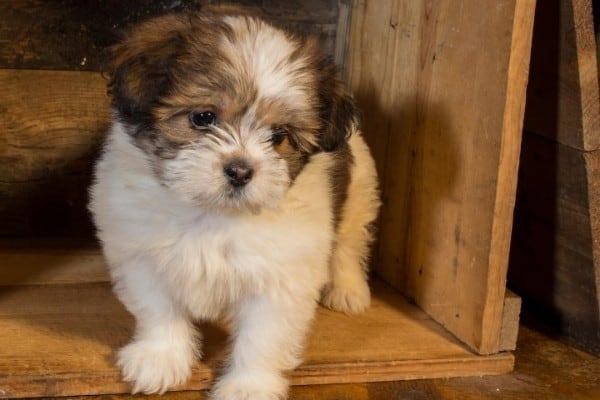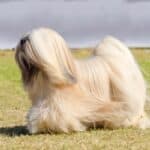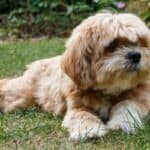If you’re looking for a small breed dog that won’t shed much, the Lhasa Apso and the Poodle may be two breeds that you’ve considered.
You may also have seen advertisements for mixes of these breeds for sale.
You may be wondering whether getting a mix produced by these two dogs is a great way to get the best of both worlds.
What is a Lhasa Apso Poodle mix? A Lhasa Apso Poodle mix is the result of breeding a Lhasa Apso and a Poodle, usually a toy or miniature Poodle. They can have straight or curly hair, weigh between 10 and 30 pounds, and may be very friendly and eager to please or a bit more reserved and stubborn.
A mix of two purebred dogs can be full of surprises.
Combining the regal-looking Lhasa Apso and the intelligent, curly-haired Poodle is bound to produce some adorable puppies, but are there specific traits that can be expected?
Take a look at what you may wind up with in terms of coat, size, personality, and health in a Lhasa Apso Poodle mix.
Predicting Characteristics in a Mixed Breed Dog
Dogs have been bred for hundreds or even thousands of years to have specific physical and behavioral characteristics.
When dog breeds are mixed, the resulting characteristics vary dramatically in the resulting puppies.
Nonetheless, it has become increasingly popular to breed purebred dogs together to create deliberately mixed breeds known as designer dogs.
The Lhasa Apso Poodle mix is such a dog.
These breeds have a number of things in common, which mixed breed puppies may be likely to inherit.
They also have some key differences which puppies may or may not inherit.
What Is a Lhasa Apso Poodle Mix?
By looking at the likely traits in both the Lhasa Apso and the Poodle, we can make predictions about the probable characteristics of the puppies.
Coat
One of the reasons that this mix is popular is because both the Poodle and Lhasa Apso have coats with hair instead of fur that don’t shed and tend to be more or less hypoallergenic.
However, just because these coats are both hair instead of fur doesn’t mean that they are necessarily very similar.
Lhasa Apso Coat
The coat of a Lhasa Apso has been in development for over a thousand years.
It evolved to withstand the harsh cold of Tibetan winters. They have double coats, which are very heavy and dense.
The outer coat tends to be quite hard and the inner coat is softer and warm.
The coat is straight, is neither silky nor woolly, and grows nearly to the ground. The Lhasa Apso can come in any color.
Poodle Coat
The Poodle coat is very curly. The texture is harsh and dense. The coat can either be clipped short, combed out to create poofy fluff, or corded into tight cords.
Most people’s image of Poodles is in a fancy cut with pompons and sculpted shapes.
This level of grooming is possible because of the dense, curly nature of the hair which can be scissor cut into practically any shape.
Poodles are supposed to be solid in color by the breed standard, although parti-colored dogs are popular as pets.
The colors that are acceptable are varying shades of white, apricot and black.
Within these colors, you can see gray, silver, blue, and cream, but the color should be more or less solid.
Lhasa Apso Poodle Coat
When the Lhasa Apso and the Poodle are mixed, the resulting coat may be anywhere between entirely straight and very curly.
It may have two layers or one, and either layer may be stronger or weaker than the other.
That means that you may have a thin outer coat that looks like wires sticking out of the fluff or a stronger outer coat that lies flat over the body.
Depending on the makeup of the coat, it may be very prone to matting.
You may find that this coat type may result in a coat that does not respond well to either being brushed out or corded.
You are likely to find that the best solution is to keep your Lhasa Apso Poodle mix’s coat very short so that it will not be as prone to matting.
Any variation of color may be possible in a Lhasa Apso Poodle mix.
However, these dogs may be a bit more prone to solid coloration since that is the standard for Poodles.
Size
Poodles come in three sizes, with each dog identical in conformation. Miniatures should be under 15 inches at the shoulder and toys should be 10 inches or less.
Generally, when Lhasa Apsos are mixed with Poodles, they are mixed with either toy or miniature Poodles.
Lhasa Apsos weigh between 12 and 18 pounds, with females tending to be slightly smaller than males.
Your Lhasa Apso Poodle mix will vary in size depending on what size of Poodle was used, but expect around 10 to 15 pounds for toy Poodle offspring and 15 to 30 pounds for miniature Poodle offspring.
Behavior and Personality
Poodle Personality
Poodles are among the most trainable and intelligent of all dog breeds.
These dogs excel in the work they were bred for – retrieving. Still, they are also excellent at agility, obedience, tracking, scent work, and as service dogs.
It is hard to find a breed more eager to please than a Poodle, but you can expect that you will need to occupy that busy mind if you expect to have a happy, well-adjusted pet.
While Poodles tend to be sensitive and may be a bit reserved with strangers, they are generally extremely friendly with everyone and adjust well to being in groups.
Lhasa Apso Personality
Lhasa Apsos are much more independent and committed to following their own minds than are Poodles.
They are very intelligent and can learn just about anything you try to teach them, but you will have to find a way to motivate them properly.
(Find tips for motivation here.)
They do not respond well to repetitive training and may become extremely stubborn if you try to force them.
These dogs functioned as alert dogs in their native Tibet, and they are still a little bit reserved with strangers.
Lhasa Apso Poodle Mix Personality
These two breeds vary dramatically in personality and trainability, so you may experience quite a range of possibilities in your puppy.
Your dog may be extremely eager to please and seem to be looking for ways to serve you even when you’re not trying to train him.
On the other hand, he may be determined to resist even the most basic commands unless he’s in the mood to comply.
Your dog may be a happy-go-lucky charmer and love meeting new people or he may be slow to warm up to your guests.
Health
Both the Lhasa Apso and the Poodle tend to be very healthy dogs, but there are some problems that may crop up in either breed, and they also may show up in your mix.
Luxating Patella
Common to most small breed dogs, luxating patella occurs when your dog’s kneecap pops out of place and may stay out of place, causing pain and impaired mobility.
Both breeds are prone to this condition.
Eye Problems
The large, luminous eyes of both of these breeds can result in some problems for them.
Poodles are prone to issues with their optic nerve and general eye issues, which require an ophthalmologist evaluation for all breeding animals.
Lhasa Apso are prone to corneal ulcers and may also develop cherry eye and progressive retinal atrophy.
Specific Genetic Conditions
Both of these breeds have some serious genetic issues that occur, although they are not common.
Lhasa Apso are prone to hereditary kidney dysfunction in mild to severe forms. There is not a reliable test to determine whether a breeding dog carries it.
Poodles are prone to Von Willebrand’s disease, Cushing’s disease, and Addison’s disease.
Misconceptions About Mixed-Breed Dogs
The increasing popularity in designer breeds is partly due to some prevailing misconceptions about mixed-breed dogs.
They Are Healthier
Mixed breed dogs may be less likely to inherit recessive traits that are predominant in a certain breed.
However, if both of their parent breeds have a recessive trait, they are just as likely to get it as the purebred dogs.
Because the physical makeup of mixed breed dogs is less predictable, they may actually be more likely to suffer from problems like joint issues.
They Are Smarter
A mixed breed dog may inherit the intelligence of either of his parents.
Unless the two dogs that are bred are both of particularly intelligent breeds, there is no reason to think a mixed breed dog would be more intelligent than a purebred dog of average intelligence.





